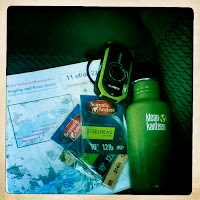Bottled water presents a hazard to our fish and to you as well. Here are two tips to help you reduce the amount of bottled water that you use.
1. Carry your water with you:
Fill a large water jug from the tap and take it with you. Refill your smaller water bottle from the jug! We fill a five gallon water jug with ice and water and set it in the back seat of the truck. We refill our smaller bottles whenever necessary. If there is water leftover at the end of the day, we set the jug on the counter at home and use it to refill our water glasses.
2. Use a hydration pack: As with the jug, fill your hydration pack from the tap and take it with you. Many packs come in large capacities, up to 100 ounces of water. You can use the large pack to refill your smaller bottle. This is a great option if for a day hike.
 |
| How I roll... |
Bottled water is costly. A glass of water from the tap costs less than a penny. A 12 ounce bottle of water will cost a dollar or more. Besides not making economic sense, bottled water is not necessarily a healthy alternative.
Generally speaking, bottled water falls under FDA standards and, in some cases, sources for bottled water do not need to meet the same standards as municipal water supplies. EPA standards, for example, require that city tap water can have no confirmed E. coli or fecal coliform bacteria. No such standard is in effect for bottled water. Indeed, stricter FDA standards regarding E. coli for bottled water did not go into effect until December 2nd, 2009.
(Mat's note: In Canada, the regulation of bottled water sold in Canada is shared by Health Canada and the Canadian Food Inspection Agency (link). Local water supplies are inspected every day, whereas bottled-water plants are inspected at three-year intervals. Read a CBC article on bottled water here.)
Why it’s important to the fish:
According to American Rivers, Laurel Hill Creek could soon have its unique character destroyed by excessive water withdrawals. According to the United States Geological Survey, 2 million gallons of water are withdrawn from Laurel Hill Creek every day. This exceeds the calculated daily safe withdrawal level by 600,000 gallons.
As if the current strains on the creek were not enough, there is a proposal on the table to withdraw up to 108,000 gallons per day from Laurel Hill Creek for bottled water! According to Clair Saylor, a life-long streamside resident, “the only way I can monitor the amount of water in the creek is to count the number of stones exposed across the creek. By that measure we’re already in crisis.”
Without water there will be no fish. When large amounts of water are withdrawn from a watershed, as water bottlers often do, the results can be disastrous. We can only tax our rivers and our aquifers so much. When we drink bottled water that is sourced from aquifers and streams, we are taxing the environment for our fish.
By using water from the tap, we help to reduce the strain on our rivers and ultimately on our fish.
-Because our lifestyle runs downstream-
********
Now that I've successfully made you feel guilty (and/or angry), here's an awesome (AWESOME) track from the Black Keys' new album, El Camino, which was released on Tuesday. Buy it. Trust me. Just buy the damn album.

No comments:
Post a Comment